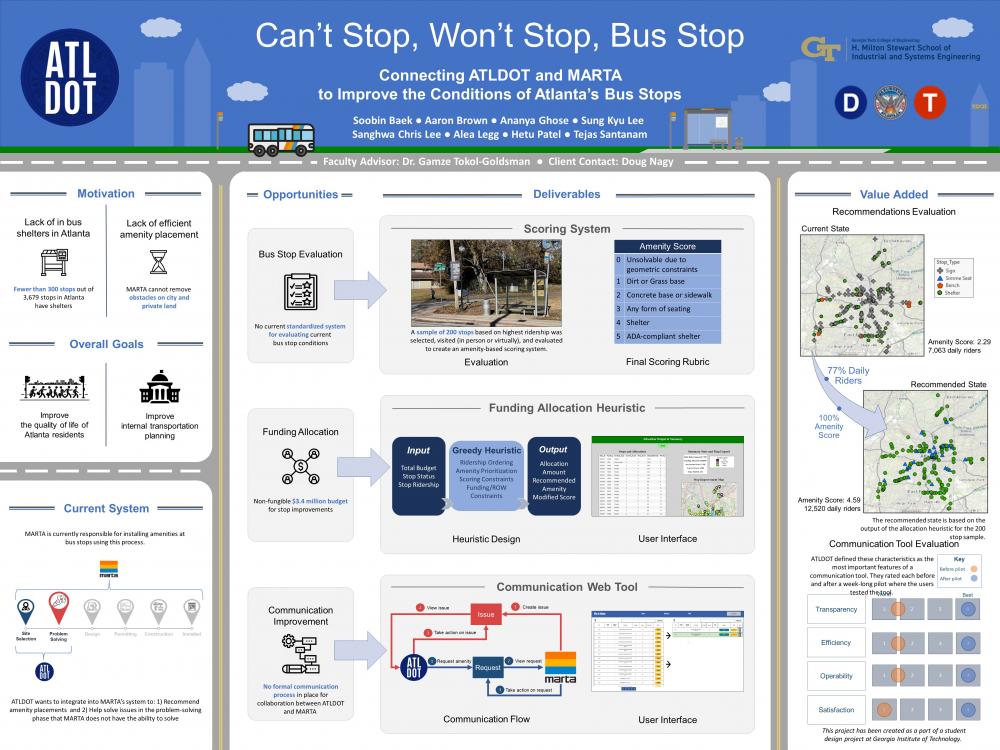Client Context
The Atlanta Department of Transportation (ATLDOT) plans and invests in projects according to the city’s evaluated short-term and long-term transportation needs. Formed in the wake of Atlanta’s population boom, ATLDOT improves the quality of life for Atlanta residents by providing “safe, accessible, and efficient” transportation solutions. The presence of amenities, such as benches and shelters, can improve bus rider experience and make stops more accessible. To achieve this, ATLDOT must integrate with MARTA (Metropolitan Atlanta Rapid Transit Authority), the predominant transit operator in the Atlanta area. ATLDOT’s goal is to improve the bus rider experience at MARTA bus stops.
Project Objective
The system under study is the placement process of amenities and other bus stop improvements at MARTA bus stops across Atlanta.
Currently, bus shelters in Atlanta are placed on an ad-hoc basis in response to community requests. MARTA attempts to correlate amenities with areas of high ridership, proximity to Points of Interest (POIs) such as hospitals and senior homes, and binding Title VI equity constraints. There is no formal, standardized system for collaboration between MARTA and ATLDOT.
According to MARTA transit system planners, five of the six steps in the amenity placement process are efficient and usually occur without issues. “Problem Solving” is the rate-limiting step of the amenity installation process. If a candidate stop for an amenity encounters unforeseen issues in this step, the stop is likely to be excluded from consideration altogether because MARTA cannot solve many of these issues on their own. However, ATLDOT has the ability, power, and resources to remove many potential obstacles faced in the “Problem Solving” step. No formal process or communication channels exist to easily facilitate this collaboration.
Out of the 3,679 MARTA bus stops in the Atlanta area, only 7.9% of these stops have bus shelters (292 stops out of 3,679). 49 bus shelters were installed in the past year. At this rate, it would take 69 years to install the remaining shelters. Deeper evaluation of internal and MARTA-collected data yielded a greater understanding of prioritization of improvement efforts and improved the transparency and efficiency of the bus stop amelioration process for both parties. The team worked with ATLDOT to refine the bus stop amenity installation process and impact the highest number of city residents by improving the client’s ability to recognize and address critical roadblocks.
Design Strategy
The following opportunities for improvement arose given the current state of the system:
1. Evaluate the current conditions of MARTA bus stops
2. Allocate funding to place amenities at MARTA bus stops
3. Improve and initiate communication between ATLDOT and MARTA
The first opportunity is necessary to diagnose where improvements are most needed, and the second opportunity aids ATLDOT in using their budget in an impactful way. Improving their budget allocation method will help ATLDOT maximize the riders they impact with each dollar. Addressing the third opportunity will allow for future collaboration between ATLDOT and MARTA to occur effectively.
For the first opportunity, a scoring system establishes a basis for evaluating bus stops based on the existing on-site amenities. Each bus stop has a mix of existing amenities that impact the rider experience at that location. Through the diagnosis of current stop conditions and creation of a uniform scoring system, a standard amenity score is determined for each stop. This score is then used as a decision-making criterion in a funding allocation heuristic.
A greedy heuristic (decision-making algorithm) is used to ensure funding allocations are made efficiently to achieve ATLDOT’s goals in the second opportunity. The previous system decided placement of amenities based on demands from the loudest speakers at council meetings and requests in public meetings. By adding an objective data-driven tool to allocate funding, the placement process prioritizes ease of use to ensure its longevity. The heuristic and the associated web tool are designed to handle the entire bus stop network; however, the recommendation focuses on the top 200 highest ridership stops, intending to gain buy-in from the mayor and other city decision-makers for expansion of the project beyond the initial stop subset. The goal of the greedy heuristic is to place as many shelters, benches, and simme seats (a type of two stool seat) as possible within the given budget at these highest ridership stops.
The goal of the communication process tool to address the third opportunity is to improve the internal amenity placement process and communication between ATLDOT and MARTA. ATLDOT has the capability to fund new amenities and secure ROW where necessary, but MARTA has jurisdiction over amenity placements. MARTA is the first to encounter roadblocks at bus stops, and some of these roadblocks may be outside of their control. By establishing a communication process across the two organizations, ATLDOT can fund amenity placement projects, and MARTA has easy access to see those recommended improvements. MARTA also benefits from this process because they can easily request help from ATLDOT in alleviating obstacles that prevent shelter placement. This collaboration tool benefits both groups by allowing them visibility into the process and quicker support in amenity placements, something that was not previously possible.
Deliverables
For easier accessibility of the allocation heuristic, the team created a website that allows multiple users to run the allocation heuristic at a given time. /. The web application version of the heuristic benefits ATLDOT through ease of access, fast runtimes, and flexibility of inputs. The allocation tool can be run on any stop subset and allows for adaptability as the given network may change. This website is free to maintain, with easy upkeep, and can be used without any coding knowledge or purchase of specific licenses. The added benefit of this website is the regular data sharing between MARTA & ATLDOT which will make the amenity placement process smoother as their partnership further develops. Designed for ease of use, the allocation tool uses a 4-step process to return heuristic results for the user. After logging in with a username and password, the user then uploads a dataset with the corresponding inputs. Next, they select the budget to allocate, and run the greedy heuristic. The website will then output the allocation results for the inputted bus stops. When running the allocation heuristic on the web application, the user is presented with a data table, an interactive map, and summary stats of the heuristic’s recommendations. The data table displays all the stops’ current amenity scores, new amenity scores, average daily ridership values, stop data, costs, recommended amenities, and priorities. The website lists the following summary statistics: daily riders impacted, funding allocated, average current score, average new score, and number of stops funded. The interactive map is linked to the data table, allowing users to see a general geographical layout of where each type of amenity placement is recommended. By selecting a row on the data table, the map will focus on that specific stop on the map. The table gives an entire network analysis, while the summary and map allow for quick understanding of the recommendations, enabling the users to make faster, data driven decisions. The other option on the website is to download the heuristic results into an ArcGIS-compatible CSV, as per the client’s request. Using the heuristic results, ATLDOT can take the recommendations and apply them to the communication tool to implement the recommended stop placements.
The team also created a communication web tool that allows ATLDOT and MARTA employees to collaborate using the designed process flow. The web tool will allow both groups to gain visibility in these processes. The tool is user-friendly and easy to maintain. Upon entering the site URL, the user is prompted to sign in or create an account with credentials from their related organization. Once the user has signed in, they will be prompted with the request or issue page depending on their organization. ATLDOT users will begin on the request page, and MARTA users will begin on the issue page. Both pages are accessible to both user groups. The website contains all 3,679 stops in MARTA’s Atlanta bus network. Each stop has a trackable history where users review past amenity requests and placement issues. Some design criteria requested by the stakeholders included the addition of wayfinding data, count of stops in a filter, and a complete list of common issues and statuses for bus stops. Through this interactive communication web tool, ATLDOT and MARTA will develop a stronger relationship through direct and structured collaboration.


